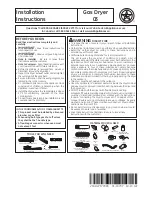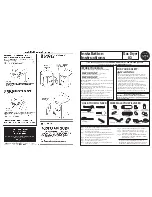
21.
Determine the length of
exhaust vent that is needed to connect
the dryer to the exhaust hood. (See
“Exhaust requirements,” Panels C and D.)
22.
Connect exhaust vent to
washer/dryer and then to the exhaust
hood.
• Use the straightest path possible to
avoid 90° turns.
• Use clamp to seal all joints in the
exhaust system.
• Use caulking compound to seal
exterior wall opening around exhaust
hood.
23.
CHECK ELECTRICAL
REQUIREMENTS. BE SURE YOU HAVE
CORRECT ELECTRICAL SUPPLY AND
RECOMMENDED GROUND METHOD.
Check the Installation Instructions to see
that you have completed each step.
Complete any missed steps before you
continue.
24.
Check that all parts are now
installed. See parts list, Panel D. If there is
an extra part, go back through steps to
see which step was skipped.
25.
Check that you removed all
the shipping pieces including the
shipping strap with its 2 cotterpins and
plug. Dispose of all materials in proper
manner.
If you do not remove the shipping strap,
your washer/dryer may “walk” away
from its location.
26.
Check that you have all of
your tools.
27.
Turn on water faucets and
check for leaks. Tighten couplings if
there is leaking.
Do Not overtighten;
this
could cause damage to faucet.
28.
Replace access panel. Be
sure to tighten the three Phillips-head
screws at the top of the access panel.
Replace the bumper under the center
screw.
29.
Read the Use and Care
Guide to fully understand your new
washer/dryer. Open dryer door. Check
to be sure lint screen is in its proper
position. Wipe out drum.
30.
Plug power supply cord into
grounded outlet. Reconnect the power
supply. Now start the washer and allow
it to complete the regular cycle.
31.
Start dryer and allow it to
complete a full heat cycle to make sure
it is working properly.
Panel F
A
B
C
strap
strap
19.
Put “hook” end of drain hose
in laundry tub or standpipe. Tightly wrap
the shipping strap around the drain
hose and laundry tub or standpipe as
shown in Figures A and B. Push plug into
the nearest hole in the shipping strap.
If the water inlet faucets and drain
standpipe are recessed, put “hook” end
of drain hose in standpipe. Tightly wrap
the shipping strap around the drain
hose and faucet body (not the handles
or stems) as shown in Figure C. Push plug
into the nearest hole in the shipping
strap.
Hose must be cut exactly to length so
“hook” end is held tightly over edge of
standpipe.
If drain hose cannot be strapped in
place, it must be cut exactly to
length so the “hook” end is held
tightly over the edge of the
tub or standpipe. See
Figure D.
If a longer drain hose is
needed, drain hose (Part
No. 388423) and hose
extension kit (Part No.
285442) are available
from a Whirlpool-
authorized
parts
distributor. If
drain hose
must be
shortened,
use hose kit
(Part No.
285442).
Note: If washer/dryer is moved to adjust
drain hose, the washer/dryer must be
leveled again. Repeat Steps 15-17.
Place cardboard under the
washer/dryer and carefully move
washer/dryer to avoid damaging floor
covering.
strap
20.
If you did not remove the
access panel in Step 11, remove three
Phillips-head screws and one bumper,
located at the top of the access panel.
Set the panel, screws and bumper
aside.
Check that hose is not twisted or kinked
and is securely in place.
level
Phillips screwdriver
pliers
utility
knife
safety glasses
gloves
adjustable
wrench (two
may be
required)
flat-blade
screwdriver
D
You have successfully installed your
new Whirlpool washer/dryer. To get the
most efficient use from your new
Whirlpool washer/dryer, read your
Use and Care Guide.
Congratulations!
Keep Installation Instructions nearby
where you can refer to them. They’ll
make reinstalling your Whirlpool
washer/dryer in another home as
easy as the first installation.
clamp



























